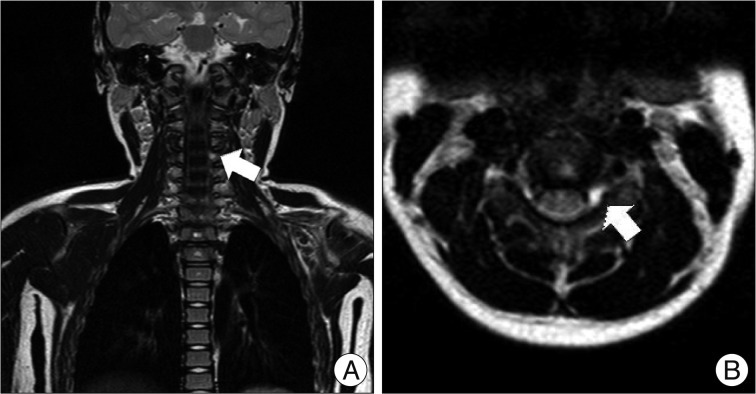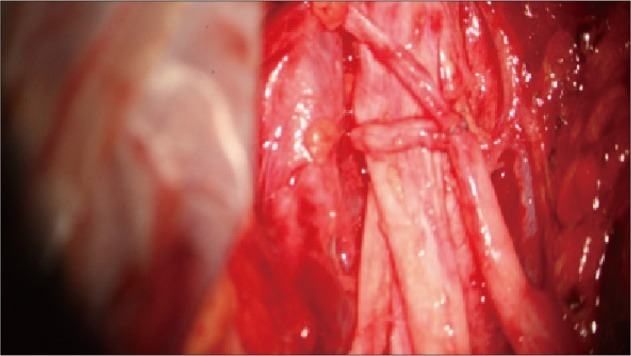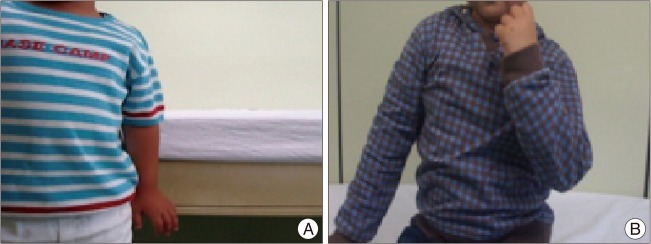J Korean Neurosurg Soc.
2012 Sep;52(3):267-269.
Neurotization from Two Medial Pectoral Nerves to Musculocutaneous Nerve in a Pediatric Brachial Plexus Injury
- Affiliations
-
- 1Department of Neurosurgery, College of Medicine, Yeungnam University, Daegu, Korea. shkim@med.yu.ac.kr
Abstract
- Traumatic brachial plexus injuries can be devastating, causing partial to total denervation of the muscles of the upper extremities. Surgical reconstruction can restore motor and/or sensory function following nerve injuries. Direct nerve-to-nerve transfers can provide a closer nerve source to the target muscle, thereby enhancing the quality and rate of recovery. Restoration of elbow flexion is the primary goal for patients with brachial plexus injuries. A 4-year-old right-hand-dominant male sustained a fracture of the left scapula in a car accident. He was treated conservatively. After the accident, he presented with motor weakness of the left upper extremity. Shoulder abduction was grade 3 and elbow flexor was grade 0. Hand function was intact. Nerve conduction studies and an electromyogram were performed, which revealed left lateral and posterior cord brachial plexopathy with axonotmesis. He was admitted to Rehabilitation Medicine and treated. However, marked neurological dysfunction in the left upper extremity was still observed. Six months after trauma, under general anesthesia with the patient in the supine position, the brachial plexus was explored through infraclavicular and supraclavicular incisions. Each terminal branch was confirmed by electrophysiology. Avulsion of the C5 roots and absence of usable stump proximally were confirmed intraoperatively. Under a microscope, neurotization from the musculocutaneous nerve to two medial pectoral nerves was performed with nylon 8-0. Physical treatment and electrostimulation started 2 weeks postoperatively. At a 3-month postoperative visit, evidence of reinnervation of the elbow flexors was observed. At his last follow-up, 2 years following trauma, the patient had recovered Medical Research Council (MRC) grade 4+ elbow flexors. We propose that neurotization from medial pectoral nerves to musculocutaneous nerve can be used successfully to restore elbow flexion in patients with brachial plexus injuries.
MeSH Terms
Figure
Reference
-
1. Brandt KE, Mackinnon SE. A technique for maximizing biceps recovery in brachial plexus reconstruction. J Hand Surg Am. 1993; 18:726–733. PMID: 8349991.
Article2. Cederna PS, Youssef MK, Asato H, Urbanchek MG, Kuzon WM Jr. Skeletal muscle reinnervation by reduced axonal numbers results in whole muscle force deficits. Plast Reconstr Surg. 2000; 105:2003–2009. discussion 2010-2011. PMID: 10839398.
Article3. Midha R. Epidemiology of brachial plexus injuries in a multitrauma population. Neurosurgery. 1997; 40:1182–1188. discussion 1188-1189. PMID: 9179891.
Article4. Midha R. Nerve transfers for severe brachial plexus injuries : a review. Neurosurg Focus. 2004; 16:E5. PMID: 15174825.5. Monreal R. Restoration of elbow flexion by transfer of the phrenic nerve to musculocutaneous nerve after brachial plexus injuries. Hand (N Y). 2007; 2:206–211. PMID: 18780054.
Article6. Narakas AO. Thoughts on neurotization or nerve transfers in irreparable nerve lesions. Clin Plast Surg. 1984; 11:153–159. PMID: 6705464.
Article7. Novak CB, Mackinnon SE, Tung TH. Patient outcome following a thoracodorsal to musculocutaneous nerve transfer for reconstruction of elbow flexion. Br J Plast Surg. 2002; 55:416–419. PMID: 12372371.
Article8. Rohde RS, Wolfe SW. Nerve transfers for adult traumatic brachial plexus palsy (brachial plexus nerve transfer). HSS J. 2007; 3:77–82. PMID: 18751774.
Article9. Samardzić M, Rasulić L, Grujicić D, Milicić B. Results of nerve transfers to the musculocutaneous and axillary nerves. Neurosurgery. 2000; 46:93–101. discussion 101-103. PMID: 10626940.
Article11. Songcharoen P. Brachial plexus injury in Thailand : a report of 520 cases. Microsurgery. 1995; 16:35–39. PMID: 7658965.
Article12. Tuttle HK. Exposure of the brachial plexus with nerve-transplantation. JAMA. 1913; 61:15–17.
Article
- Full Text Links
- Actions
-
Cited
- CITED
-
- Close
- Share
- Similar articles
-
- Multiple unilateral variations in medial and lateral cords of brachial plexus and their branches
- Intercostal nerve transfer for the treatment of brachial plexus injury
- Quantification of the Nerve Fiber of the Terminal Branches of the Typical Brachial Plexus
- Multiple neurotization in Preganglionic Whole Arm Type of Brachial plexus injury
- Bilateral variant locations of the musculocutaneous nerve during ultrasound-guided bilateral axillary brachial plexus block: A case report




